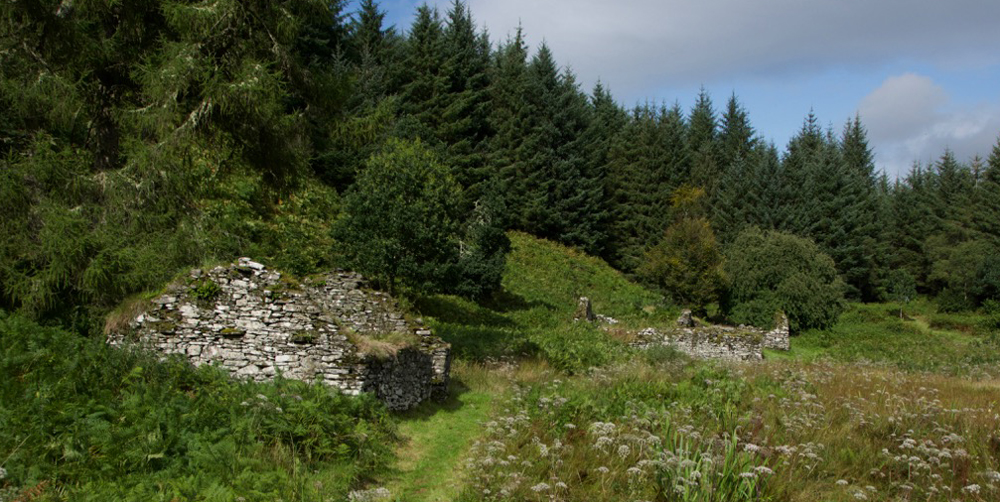
From Arichonan to Kilmory Oib
Last month, when I was wandering around the enigmatic ruins of Arichonan in the rain, I heard about a nearby settlement called Kilmory Oib which shares a similar history.
I couldn’t help but feel that an important piece of the story was left untold, so yesterday we sallied forth, in much sunnier weather, to look for it.
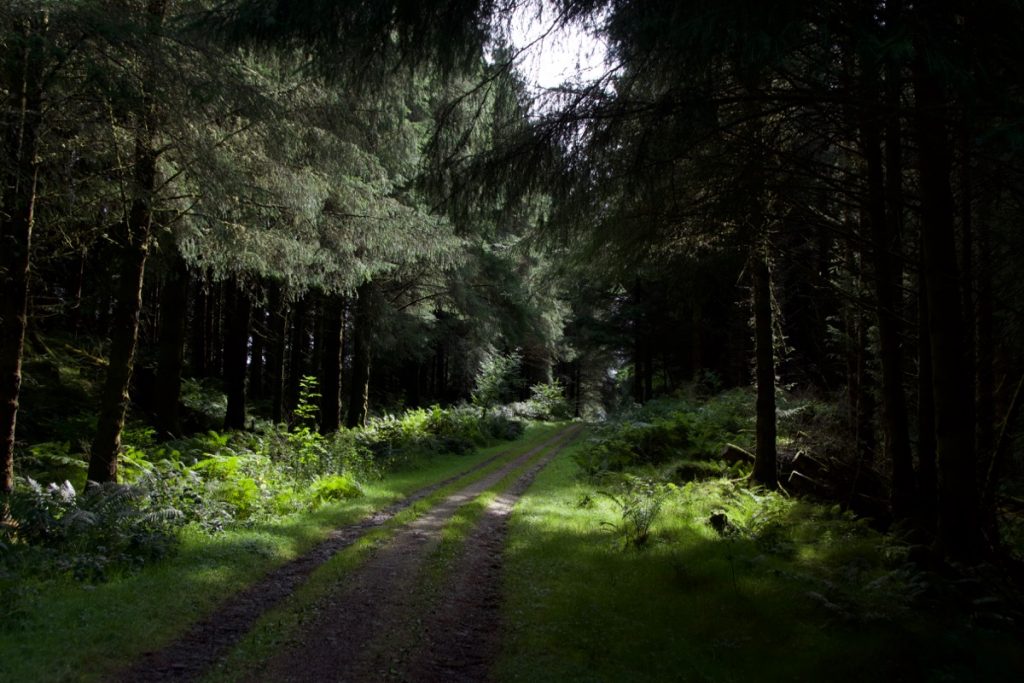 Kilmory Oib lies a short distance down a forest track, and was easier to find than I imagined. Seeing the roofless gables protruding above a sea of bracken, we paused to look at an information board which gave a layout of the site and described the agricultural activities of its former inhabitants, from the late 16th century until the mid-1800s. They grew corn which they dried in circular kilns, and took it to a nearby mill for grinding. The field in front of the houses, now overgrown with bracken and wild angelica, would once have been sown with a crop such as potatoes, and cattle would have grazed in the pasture. The residents also fished – the sea, after all, is little more than a stone’s throw away – and there would have been trout in the inland loch of Coille Bharr.
Kilmory Oib lies a short distance down a forest track, and was easier to find than I imagined. Seeing the roofless gables protruding above a sea of bracken, we paused to look at an information board which gave a layout of the site and described the agricultural activities of its former inhabitants, from the late 16th century until the mid-1800s. They grew corn which they dried in circular kilns, and took it to a nearby mill for grinding. The field in front of the houses, now overgrown with bracken and wild angelica, would once have been sown with a crop such as potatoes, and cattle would have grazed in the pasture. The residents also fished – the sea, after all, is little more than a stone’s throw away – and there would have been trout in the inland loch of Coille Bharr.

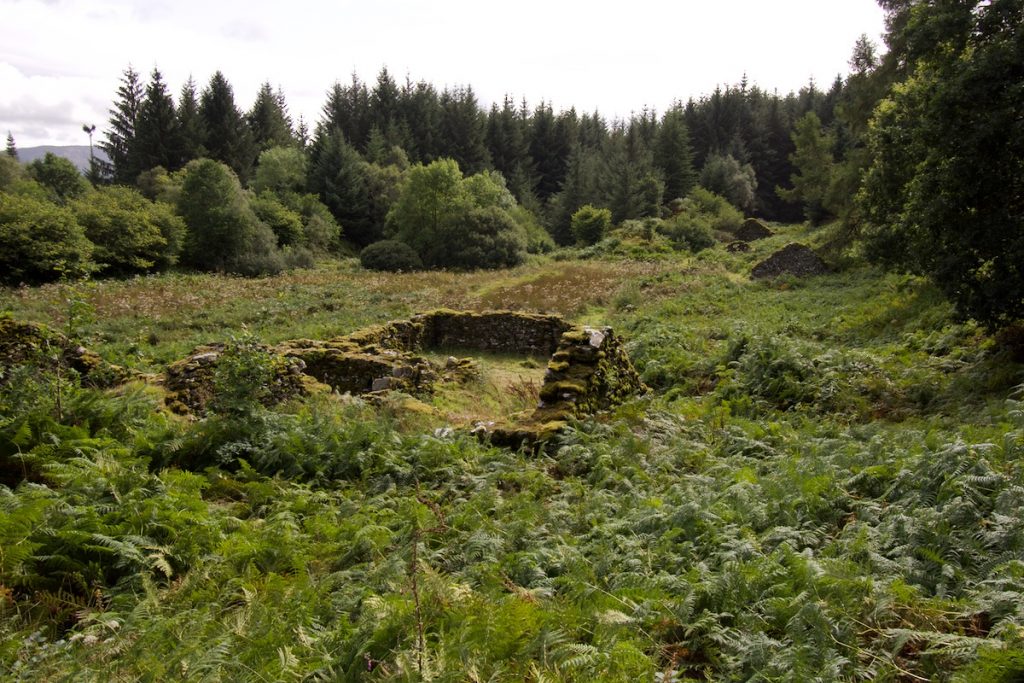 Alongside the dwelling houses were cow byres and barns. The Kilmartin Museum survey has revealed 17 structures in all.
Alongside the dwelling houses were cow byres and barns. The Kilmartin Museum survey has revealed 17 structures in all.
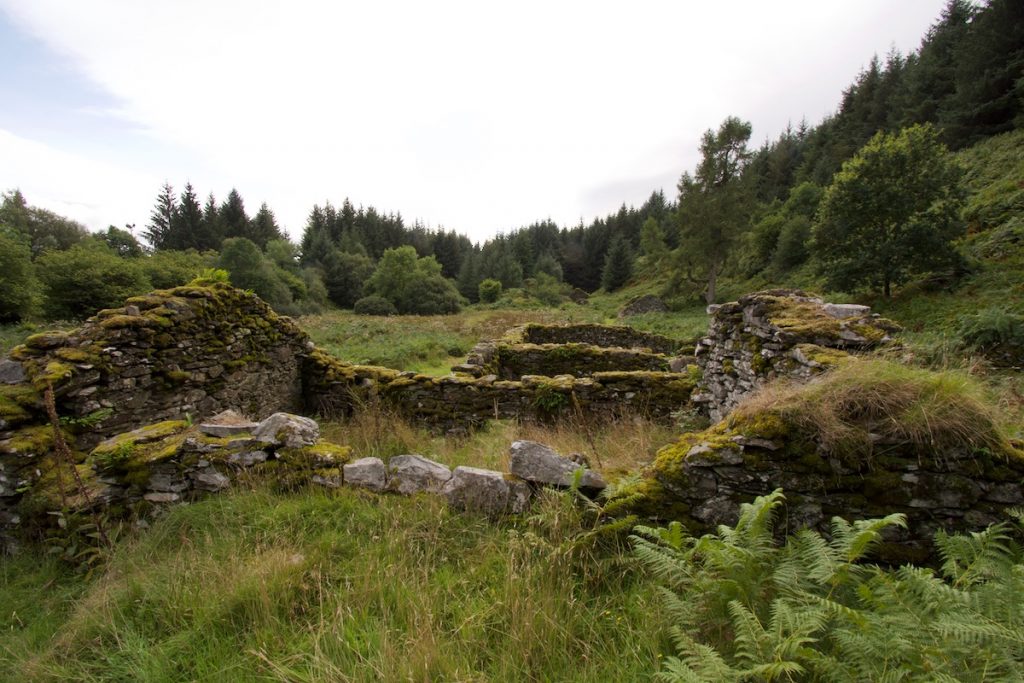 I was curious to know the origin of ‘Oib’ as a place-name, and found this explanation on the Kilmartin Museum website:
I was curious to know the origin of ‘Oib’ as a place-name, and found this explanation on the Kilmartin Museum website:
“The settlement of Kilmory Oib lay within the land or estate known as Oib (also Oab or Ob meaning in Gaelic bay or inlet) which covered two peninsulas at the head of Loch Sween…”
Other local names with the ‘oib’ element are Oibmore, Oib Greim and Gariob.
According to the Kilmartin Museum website, the earliest record of named tenants at Kilmory Oib comes from the 1694 Hearth Tax, when the inhabitants of Kilmory were listed as being Alexander and Malcolm McIlvernock, Robert Campbell and Donald McMillan. By the time of the 1841 census, there were 34 people among seven households, one of which was kept by Niel MacCallum, a ‘millar at Loch Choilliebar’. In 1843, Angus and Archibald McDugall, John Gillies and Neil McCalum (possibly a different spelling of the 1841 census entry) were liable for Road Tax. (The old road which leads past Kilmory Oib is grassy but well-built, with stones carefully placed, and domed with a ‘crown’ in the middle – likely to be from that time).
It all sounds like a thriving and prosperous community, but from the mid-1800s things went badly wrong. The Highland Clearances saw many thousands of people removed from their homes, some voluntarily but most against their will, to make way for a new and ‘improved’ method of agriculture – large-scale sheep farming. At Arichonan, an eviction notice served in May 1848 resulted in a riot, supported by many tenants of Kilmory Oib who no doubt sensed their own fate in the offing. But it was no use. Some of the people who were moved out of Arichonan came to Kilmory temporarily, before moving on elsewhere. The 1851 census records 91 people in 16 households; 10 years later, in 1861, no residents are recorded at all. Meanwhile, some of the abandoned houses were re-designed as sheep shelters – doors and windows were blocked up, and low entrances or ‘sheep crawls’ were inserted, just big enough to allow a human to get inside as well. I didn’t try it myself!
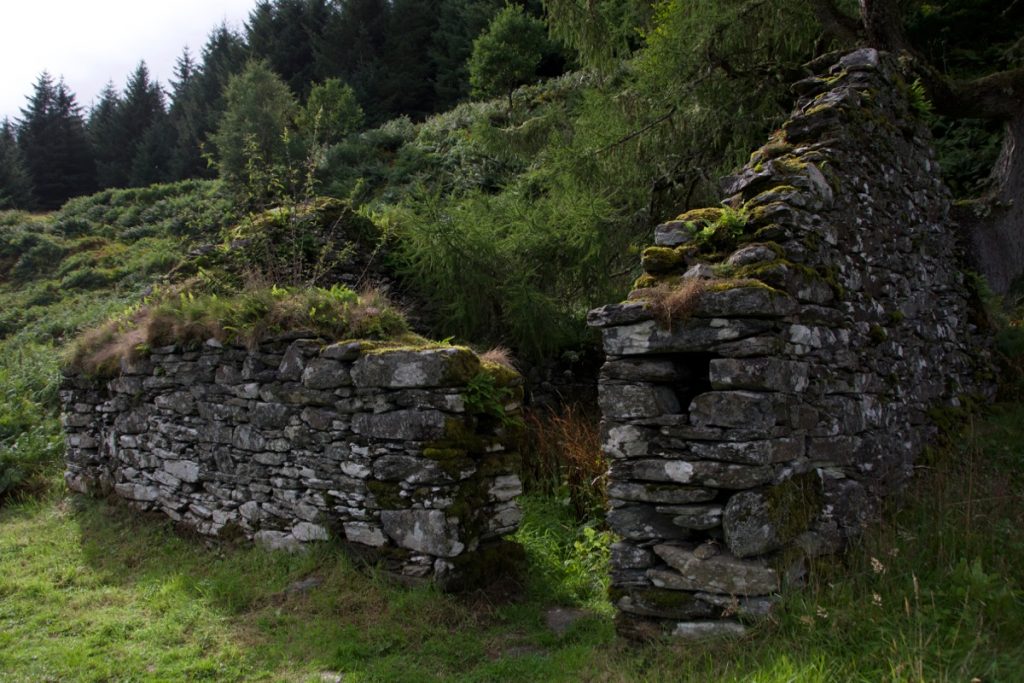
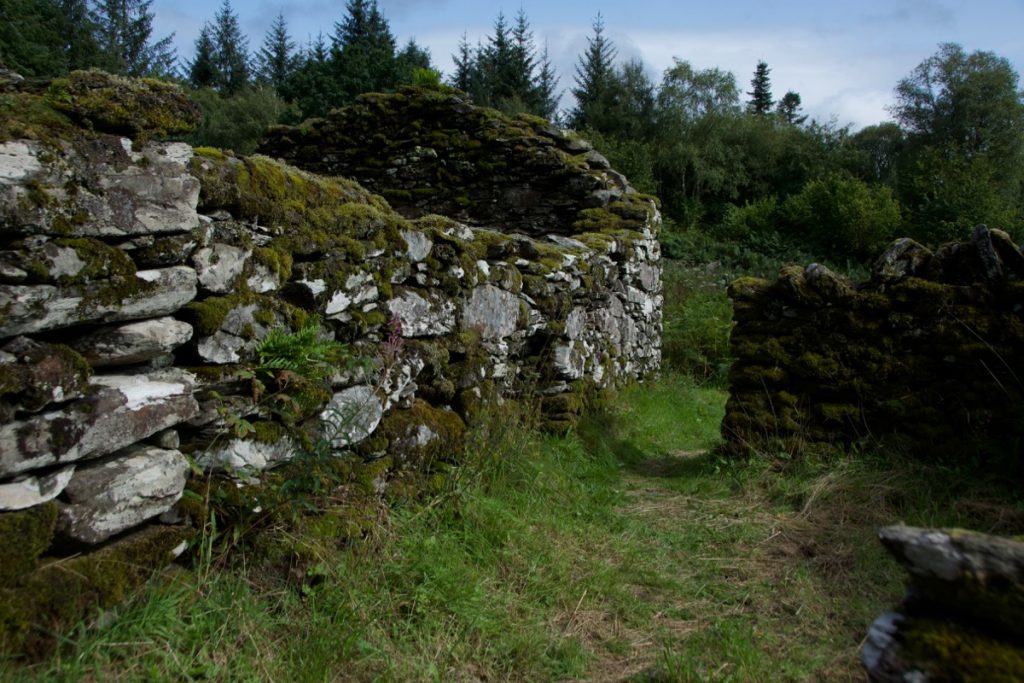
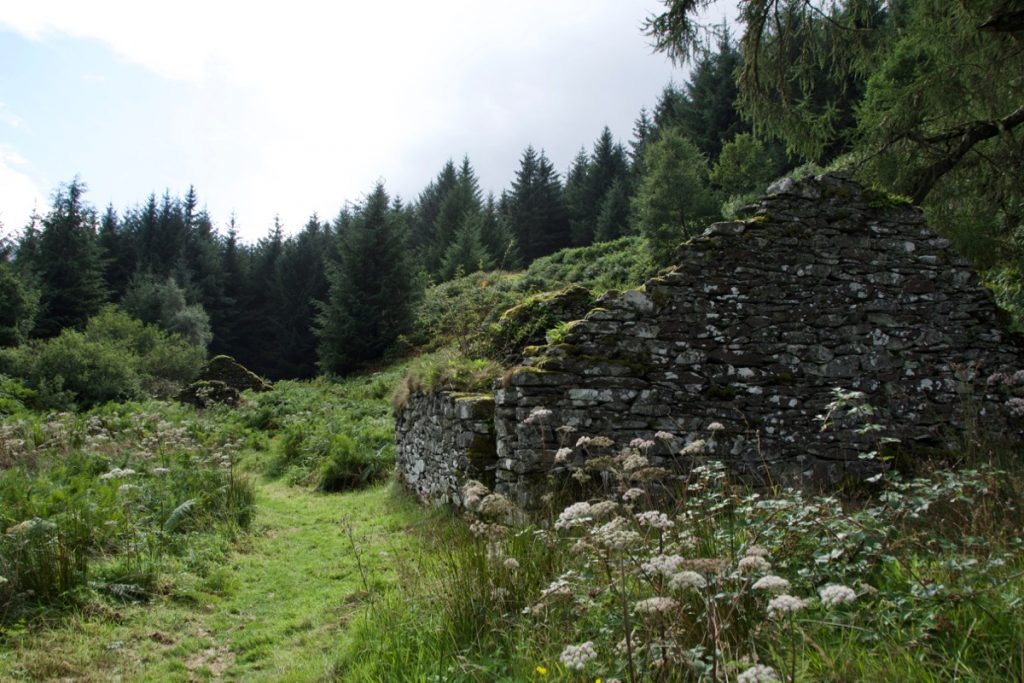
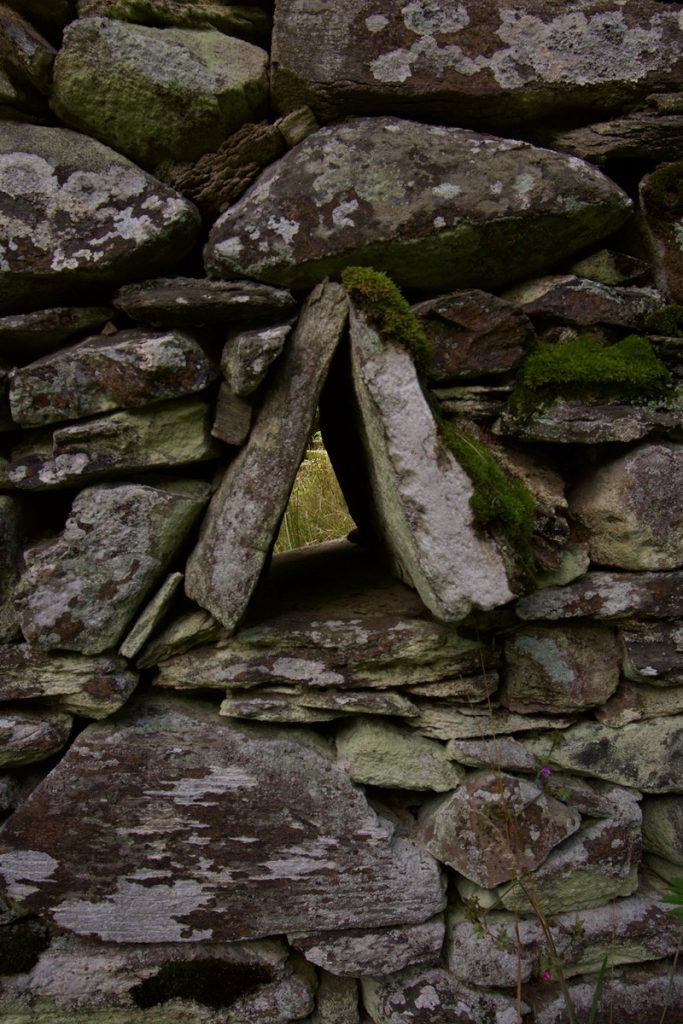
Triangular window, presumably for ventilation in a barn. Similar windows were seen at Arichonan.
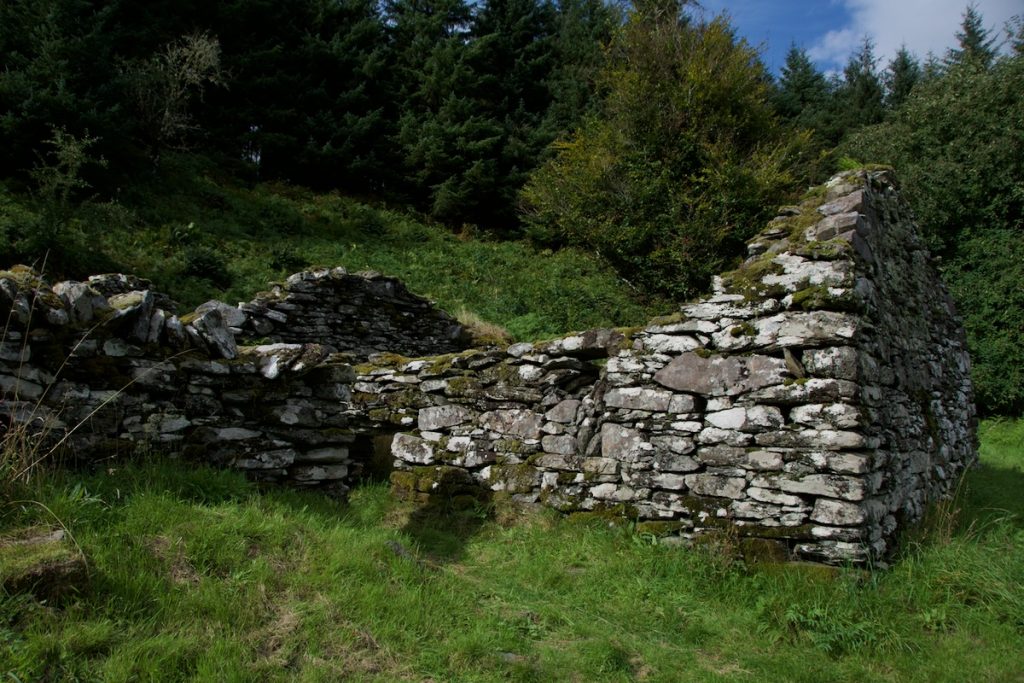
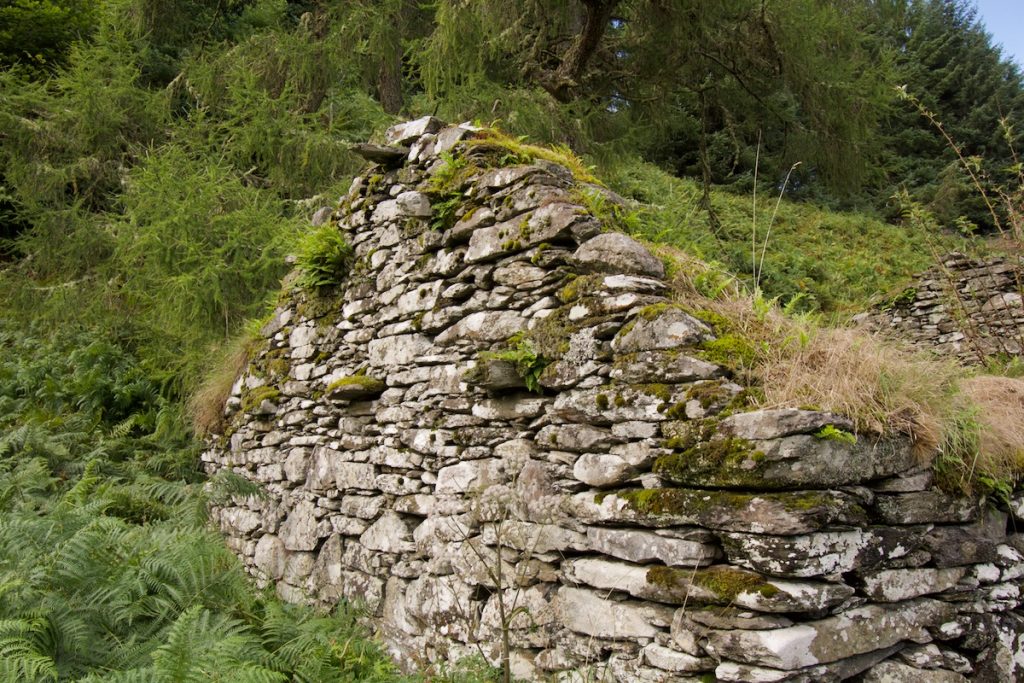 Gable end, showing thatch pegs
Gable end, showing thatch pegs
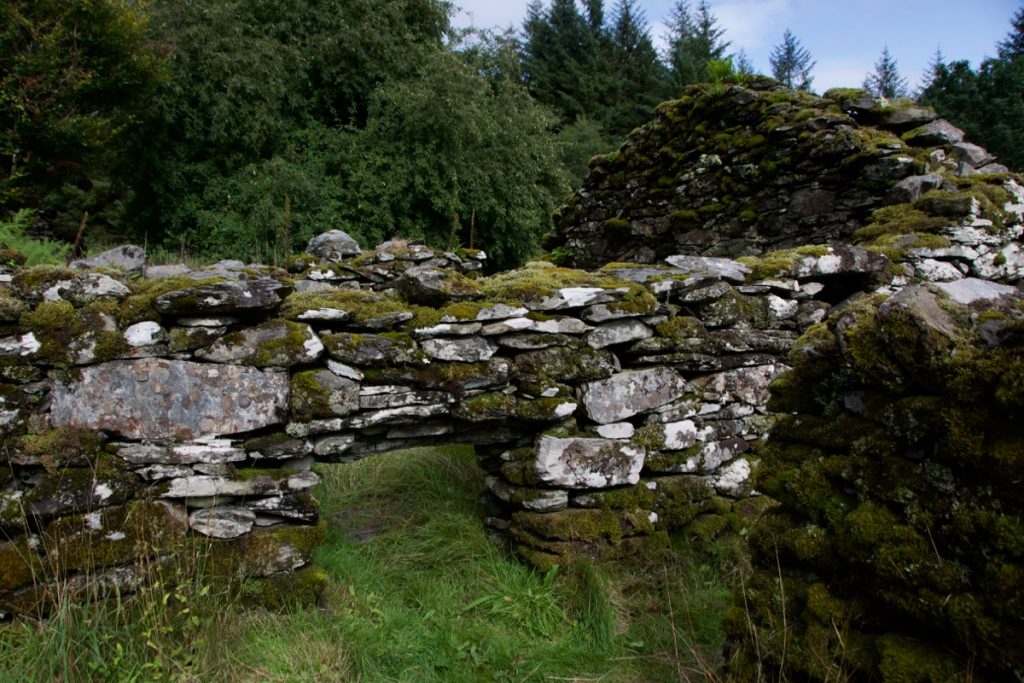
A ‘sheep crawl’
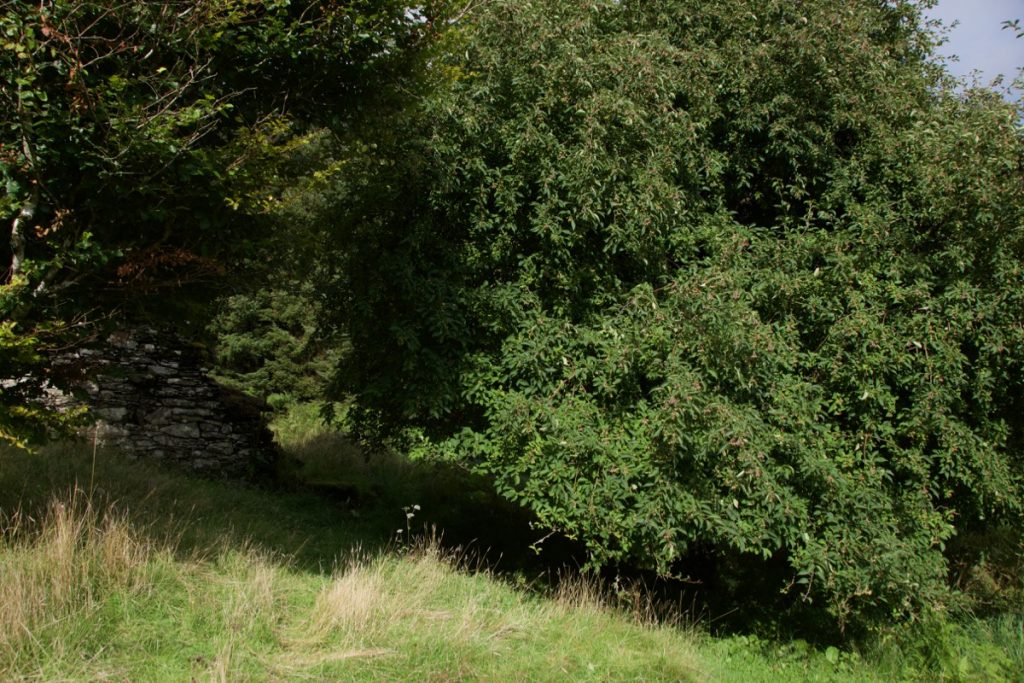
Above & below: Next to one of the barns was a magnificent wild cherry* tree – it must be the biggest I’ve ever seen. It will be lovely to come back here in autumn when the leaves are turning, and in spring to see it decked in blossom. I wonder also who planted it, and how long ago? What does it remember?
(* Thanks to a kind commenter (below) who has pointed out that it’s most likely a crab apple – of course! And what a bumper crop!)
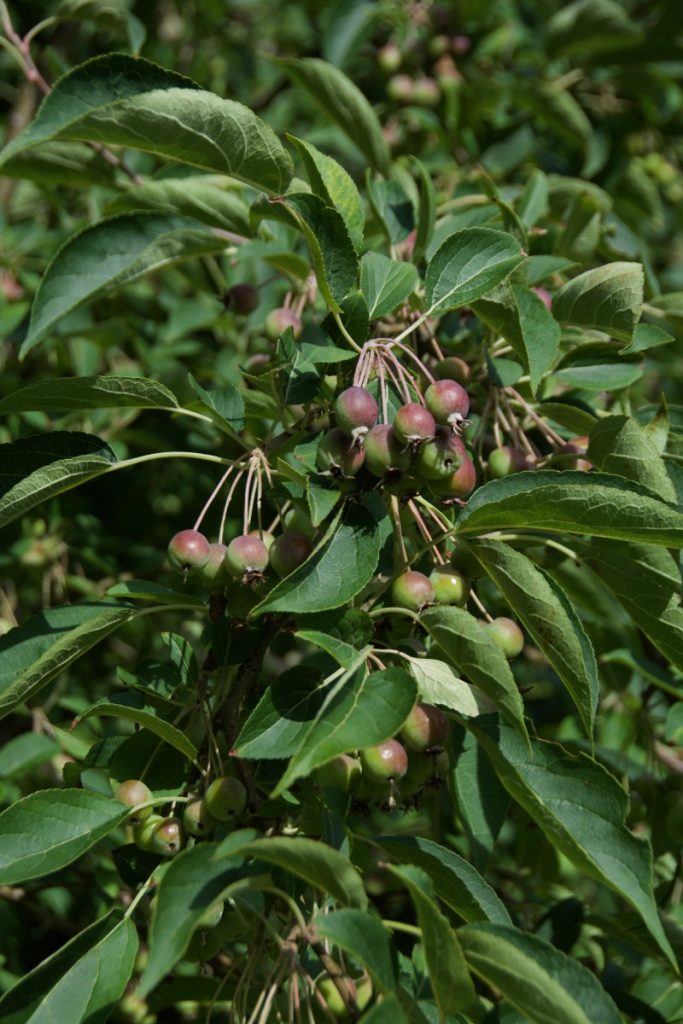
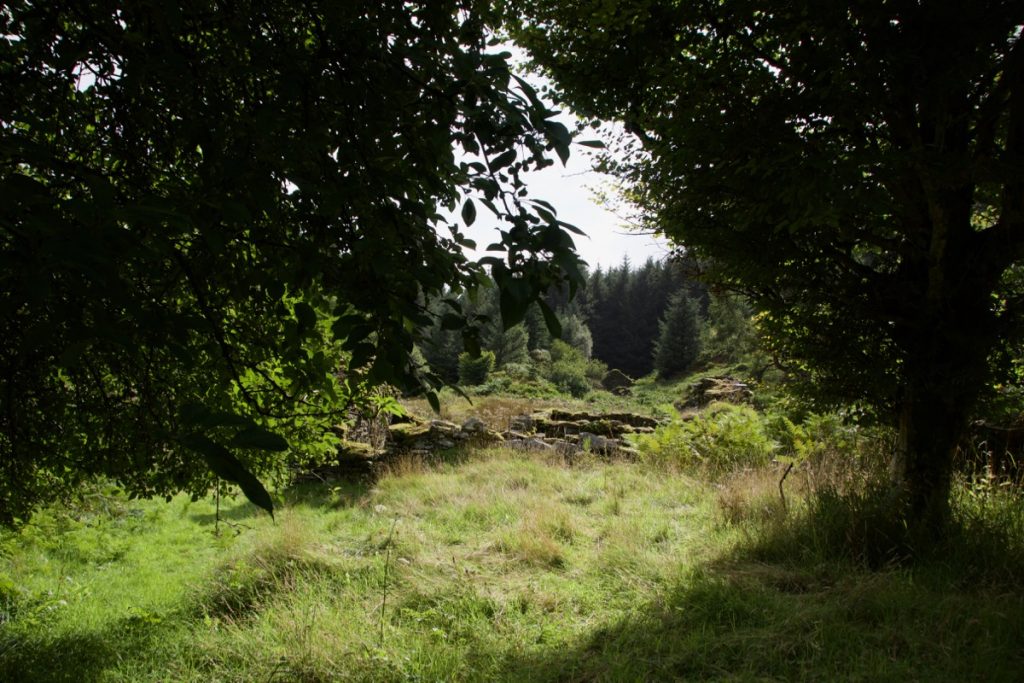 The last residents of Kilmory Oib are thought to have been two women – Euphemia and Catherine Blue. Catherine, quite likely an old lady, was listed as living at ‘Kilmory Cottage’ in 1901. According to Kilmartin Museum, in 1908 the building was photographed without a roof. I wonder what became of her, and her family, if she had any.
The last residents of Kilmory Oib are thought to have been two women – Euphemia and Catherine Blue. Catherine, quite likely an old lady, was listed as living at ‘Kilmory Cottage’ in 1901. According to Kilmartin Museum, in 1908 the building was photographed without a roof. I wonder what became of her, and her family, if she had any.
And the first residents? There may well have been a settlement at Kilmory Oib long before the 1600s – it’s just that no real evidence has yet been found.
On Blaeu’s map of Knapdale in 1663 (based on Pont’s survey of c.1590), a place named as ‘Oib’ is marked by a cross, which usually signifies a chapel or church. So far, no trace of a chapel has been found at Kilmory Oib, but towards the southern end of the village is a beautiful cross-carved stone standing next to a well. Thought to be 8th or 9th century, the stone has a cross carved on the west face, together with a pair of birds (almost impossible to make out) and circular designs like bosses, which I’ve seen on much bigger, better preserved crosses elsewhere. You can see a clearer photo of the carvings on the Canmore database, taken before lichen obscured the details. On the east face is the outline of a simple cross.
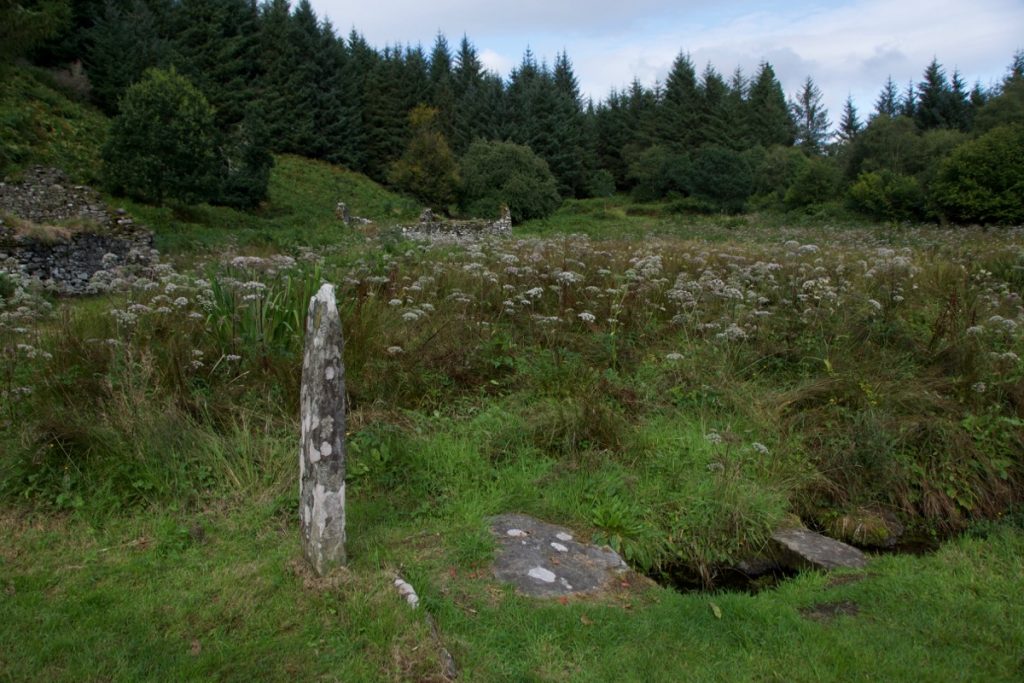
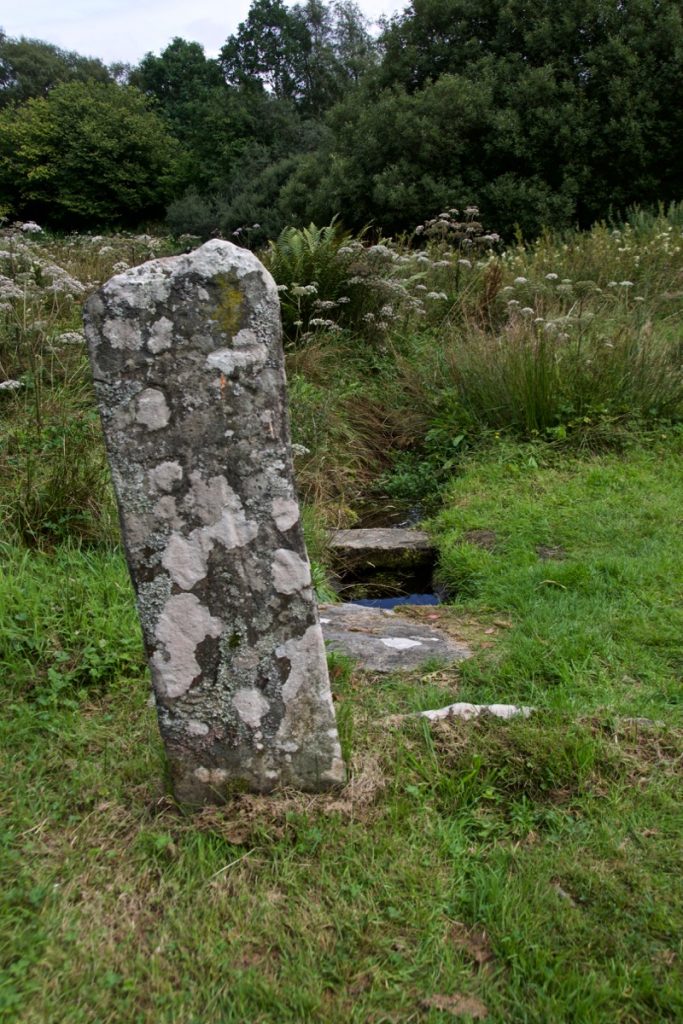
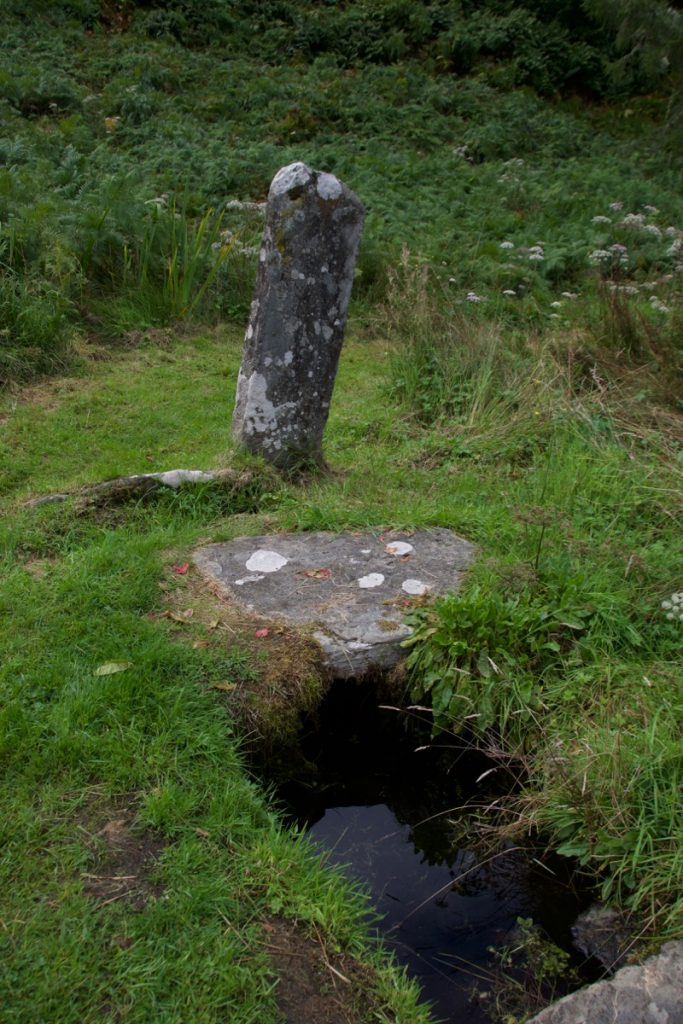 At the foot of the stone, horizontal slabs partly cover a spring which contains crystal clear water. Surely a healing well, and possibly linked to a saint who was here… but who? Is the clue in the name, Kilmory? The ‘kil‘ or ‘cille‘ element denotes a hermit’s cell, and suggests the presence of an Irish missionary-saint, one of many who came to western Scotland in the wake of St Columba. The website Saints in Scottish Place-names lists possible connections with St Mael Ruba or St Mary, but there’s no conclusive answer. All I can tell you is that it’s a truly beautiful little spot – comfortable and welcoming, rather than austere and overpowering. It needs no great leap to imagine a healer or a hermit living here in simple happiness.
At the foot of the stone, horizontal slabs partly cover a spring which contains crystal clear water. Surely a healing well, and possibly linked to a saint who was here… but who? Is the clue in the name, Kilmory? The ‘kil‘ or ‘cille‘ element denotes a hermit’s cell, and suggests the presence of an Irish missionary-saint, one of many who came to western Scotland in the wake of St Columba. The website Saints in Scottish Place-names lists possible connections with St Mael Ruba or St Mary, but there’s no conclusive answer. All I can tell you is that it’s a truly beautiful little spot – comfortable and welcoming, rather than austere and overpowering. It needs no great leap to imagine a healer or a hermit living here in simple happiness.
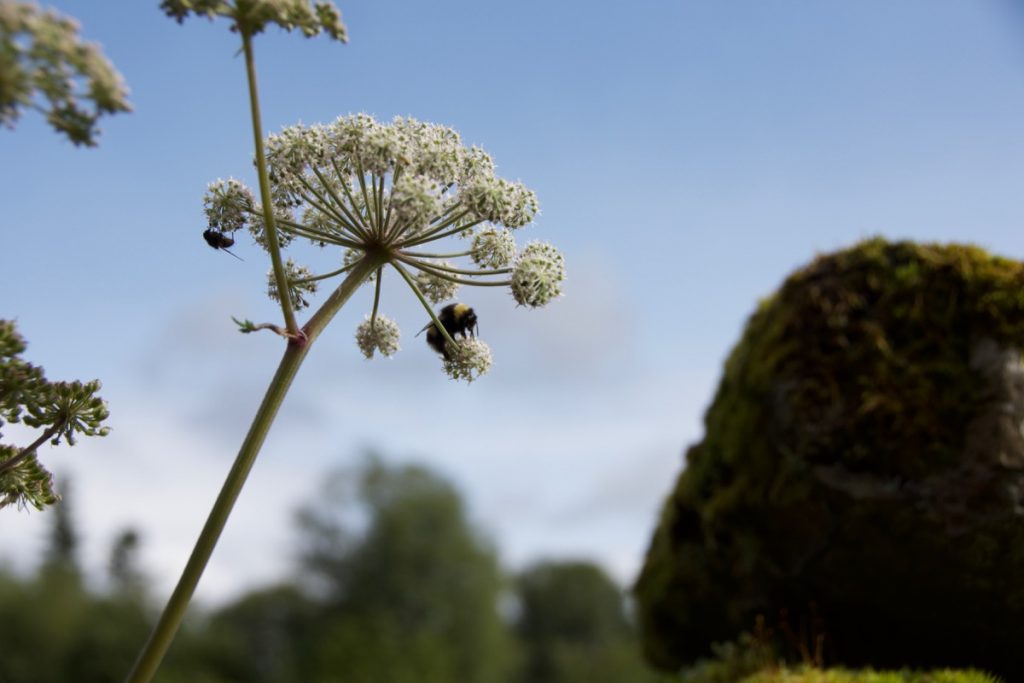
A little further along the path is the ruined mill house… I’ll tell you more in the next post.
Reference and further reading:
Photos copyright © Jo & Colin Woolf

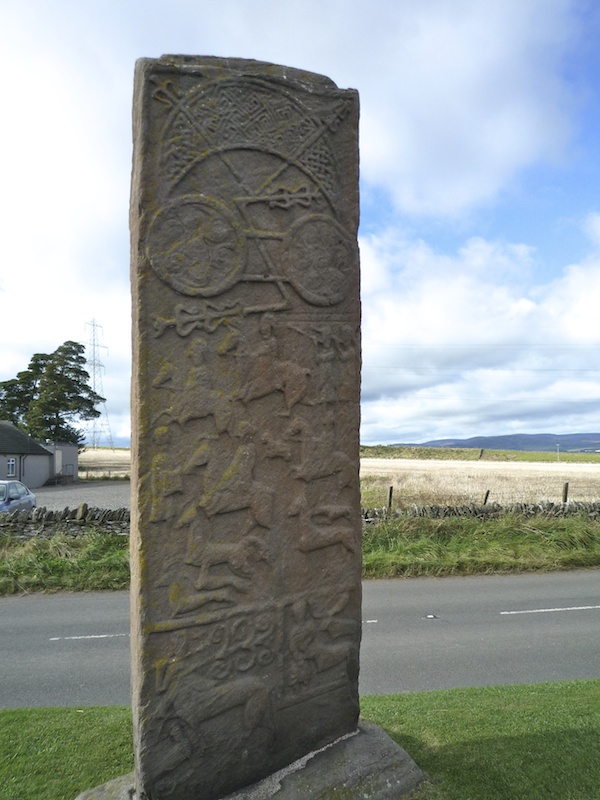
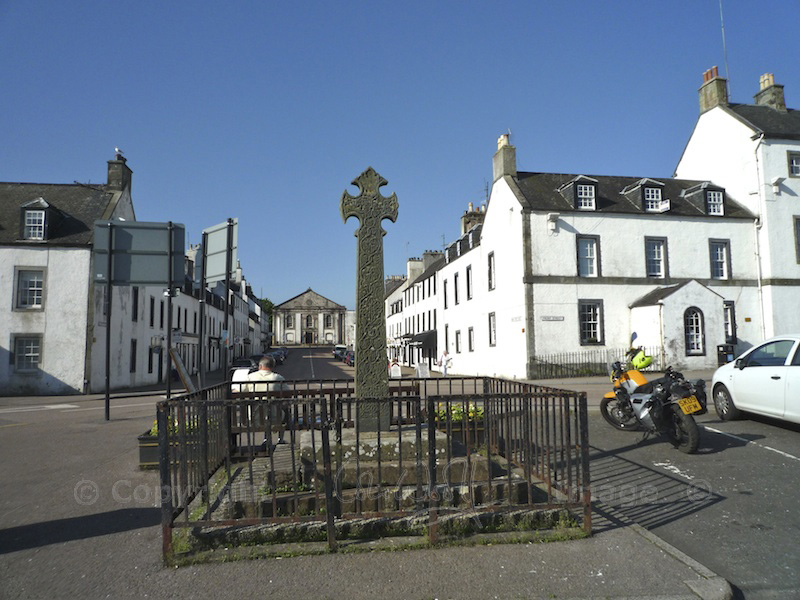
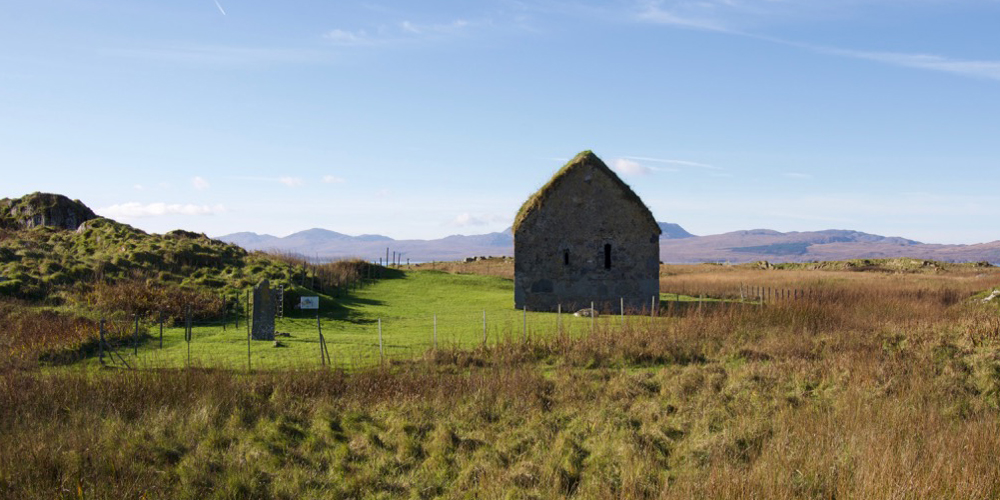
17 Comments
montucky
Fascinating history!
Jo Woolf
Yes – and the continuity of it, from such early times – that’s what I love too! I think I must have an obsession with these early saints!
boveybelle
Wonderful post. I wish we’d known about this place when we were visiting Kilmartin Glen (many years ago now – probably 20). I am interested in the animal? figures at the very top of this cross on the Canmore entry – a fragment of a hunting scene perhaps? Or just deer? I looked up my ECMS but just a written reference in there rather than an illustration.
The cherry tree looks like a Crab Apple tree to me, worth going back as they make a wonderful jelly!
Jo Woolf
Hello, and thank you for your comment! I know, what a fabulous and intriguing place it is. Firstly re. the carvings on the cross – the only descriptions I’ve come across are ‘animals’, but they could well be deer, or even more birds. Sadly, they are eroded too much to be clear.
You’re so right about the crab apple – never entered my head, but of course they’re tiny apples. Thank you! I will go back there for autumn colour and to collect some! It’s a magnificent tree.
davidoakesimages
Love the story. Another wonder of the Kilmartin Glen which just seems to get another discovery added everyday! We call it progress, but I always feel so sorry that we have lost all these communities (across the UK in all terrains). Those ‘apples’ look rather strange to be in bunches, like cherries normally form, but do look more like apples…..though our Crab’s are on single stalks.
Jo Woolf
I know, David, there are so many ‘what ifs’ throughout history. You can’t help but be moved by these old places because you can sense the feeling that comes with having lived there so long.
Maybe that’s what fooled me about the ‘cherries’! I’ll go back in a couple of months to see!
Lorna
Lovely photos. There must be so many stories hidden away or forgotten about the people who once lived there. It’s strange to think of it being a thriving community when you see it now. I wonder if it’ll ever be inhabited again, it’s hard to imagine in this modern age but you never know what might happen in the future.
Jo Woolf
I know, Lorna, you feel you can almost see it still inhabited, through the corner of your eye. Yes, who knows? It would be a beautiful place to live.
Jim Fisher
Thank you for posting this article. It is very likely that the Neil McCallum who lived in Kilmory Oib is my 4th Great Grandfather. The daughter of a Neil McCallum from Kilmory Oib, Sarah, married a John Campbell in March, 1816, North Knapdale.
Jo Woolf
Oh my goodness, that’s amazing! So he was the miller? Well done on tracing your ancestry back that far and thank you so much for telling me about your connection. Have you ever visited Kilmory Oib? We were down that way again at the end of October. It’s the most beautiful tranquil spot.
Jo Woolf
PS: Just in case you might have missed it, there’s also an article about the mill itself, which you might find interesting: https://thehazeltree.co.uk/2018/08/25/the-dark-mill-of-coilebar/
Stephen McVarnock
The McIlvernocks mentioned here are ancestors of mine – to what extent I’ve yet to figure out.
I’ve tracked the McIlvarnocks/McIlvernocks ancestral line back to 1829 in Belfast, Northern Ireland and I’ve discovered many McIlvernocks around Knapdale going back to the 16th, 17th and 18th centuries but I’ve yet to discover the direct connection between the two groups.
So I find this article and the mention of Alexander and Malcolm fascinating. I have a visit to the Oib on the bucket list at some point though!
Jo Woolf
Wow, that sounds exciting! There must surely be a connection somewhere. I’m sure you would enjoy a visit to Kilmory Oib and Arichonan. They’re so quiet and peaceful, yet so atmospheric.
Patrick Graham
Like Stephen McVarnock, I too believe I am a direct descendant of a family that used to call Kilmory Oib home. Some of my family moved from the Knapdale area to America in the 1760s. Duncan Graham of Oib is referenced as a commissioner in a tax document in 1762. The Hearth Tax of the 1690’s lists all the Grahams at that time as MacIlvernocks. Many family histories reference Archibald Graham as one of the more distinguished members of the MacIlvernock Graham family for becoming the last bishop of the Isles in 1680. A story about a place called Kenneth’s Tomb in Tayvallich written in the 1830s says that in 1590 the Graham of Oib was responsible for avenging the MacNeil of Taynish by killing Kenneth MacLean in that spot. I think it may have been part of the ongoing Battles of the Western Isles between the MacLeans and MacDonalds. Going back a little further the earliest member I’ve found reference to is simply known as Oibb Graham and in the 1710 book on the Peerage of Scotland it says that he was the third son of John “The Bright Sword” Graham of Kilbride, who lived 1427-1471. Fast forward to today, several members of the family have taken Y-DNA tests, including FTDNA’s most comprehensive Big Y 700 test. We have seen through these Y-DNA tests that several descendants of the Graham surname are descended from the same male lineage as people who have the last name Warnock and McIlvernock or some other spelling. There was one ancestry dna match between a descendant of the Grahams of Nedderly and Esk and a descendant of the Grahams of Oib which corroborates the Peerage of Scotland reference to them both descending from John of the Bright Sword Graham, although its possible the match could be from some other connection.
Thank you so much for sharing these pictures!
Jo Woolf
How very interesting! I love the sound of John ‘The Bright Sword’ Graham of Kilbride. They knew how to name their heroes in those days! I feel as if there are some stories there! Very interesting too to hear about your family members who have traced their DNA and found those early connections. I can see that a huge amount of research has gone into this. I hadn’t heard of Kenneth’s Tomb at Tayvallich – I did a quick search on Canmore’s database and found this, which might be of interest: https://canmore.org.uk/site/39093/carsaig We’ll have to pay a visit!
Thanks so much for sharing your story – it’s always lovely to hear from people who have ties to these amazing places. Let me know if I can be of any help (email is jo@thehazeltree.co.uk) and I’ll keep you posted if I find something of interest!
seharford
My maiden name is Warnock. My father and his brothers told us that family lore said that the name at one time was Mcvarnock. Oral history says the family was forced off of their land in the area of Argyll, Scotland. Although unverified, there is information in the Dictionary of American Family Names that says Warnock is an Anglicized form of the Gaelic “Macgioll Mhernog” which means son of the devotee of St Mearnog. St Mearnog is a patron saint of Kilmarnock. Perhaps he is the the Irish missionary saint who once wandered these lands.
Thanks for your lovely photos and beautiful description of this area. I hope I can come some day, and see this lovely area in person. Thanks also to Stephen and Patrick. They confirm some of what I know. I also have heard that we are possibly descended from a third son of John “The Bright Sword’. My research says he was Lord of MacIlvernock but I have not been able to verify this information,
Jo Woolf
That’s very interesting! I can see how Warnock is thought to be derived from MacIlvernock. Have you looked on the website Saints in Scottish Place-names for Marnock and its variants? It throws up some interesting connections – it offers suggestions for related sites/saints, as far as is known.
https://saintsplaces.gla.ac.uk/saint.php?id=136
I’m really glad you enjoyed this post – thank you for your kind comments – I do hope you can visit in person some day! With best wishes, Jo